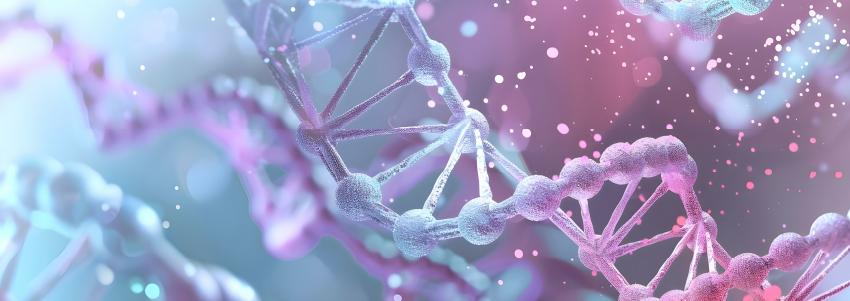Dr. Liz Bartman

There is a dial on the DUTCH test that leads to a lot of confusion amongst providers. That dial is the “methylation” dial. Too often, the knee-jerk response to this term “methylation” is to assume that it is in reference to MTHFR. Yes, MTHFR is a methylation enzyme, but when we discuss estrogen detox, and specifically phase 2 detox dependent on methylation, this is a very different pathway, dependent on SAMe, our master methyl donor, created in part by MTHFR and the folate-dependent methylation cycle, but not directly related to MTHFR.
Let’s dive into the unique distinctions, and why it matters.
Methylation Cycle
The Methylation cycle is composed of two segments: the folate-dependent segment, and the folate-independent segment.
MTHFR is near the start of the folate-dependent segment of the methylation cycle and is the rate-limiting enzyme for this segment, meaning that a reduced function in MTHFR activity can diminish the rate of production of 5-methyltetrahydrofolate.
MTHFR irreversibly reduces 5,10-methylenetetrahydrofolate to 5-methyltetrahydrofolate. This is a one-carbon methyl group that can be used for purine synthesis and for deoxythymidine monophosphate production, the thiamine pyrimidine of DNA. 5-methyltetrahydrofolate is used by methionine synthase (MS or MTR), an enzyme that requires methyl-B12 to catalyze the re-methylation of homocysteine into methionine. This enzyme uses the one-carbon methyl group from 5-methyltetrahydrofolate in this re-methylation reaction.
Methionine is further converted to S-adenosylmethionine (SAMe). This reaction requires magnesium.
SAMe is the master methyl donor used by methyltransferase enzymes. There are many classes of these enzymes, but the most important for this conversation are the class of “Natural Product Methyltransferases.” These enzymes include:
- Phenylethanolamine N-methyltransferase (PNMT), which converts norepinephrine to epinephrine.
- Histamine n-methyltransferase (HNMT), used to methylate histamine intracellularly.
- Catechol-O-methyltransferase (COMT), used to degrade catecholamines including dopamine, norepinephrine, epinephrine, coffee, chocolate, quercetin and the catechol estrogens (2-OH and 4-OH).
There is also a folate-independent pathway for homocysteine re-methylation to methionine. This is via the BHMT enzyme (betaine-homocysteine methyltransferase). This enzyme is zinc-dependent and will transfer a methyl donor from Trimethyl glycine (aka TMG or Betaine) to homocysteine, resulting in the re-methylation of methionine, which can then convert to SAMe. As an aside, betaine can be derived from choline, which is why PEMT is so important as an enzyme, as it generates de novo choline in our liver, which can become betaine, which is a methyl donor to homocysteine.
Methylation Detoxification
Methylation detox is one of several phase 2 detoxification pathways. As a recap, phase 2 detox pathways include:
- Methylation
- Sulfation
- Glucuronidation
- Glutathione conjugation
- Acetylation
When we talk about phase 2 detoxification, we are talking about conjugation, a process that involves the liver attaching a molecule to an intermediate toxin to “deactivate” it.
Methylation detox specific to estrogen requires that we have SAMe as our methyl donor and are using COMT to donate that methyl group to the catechol estrogens (2-OH and 4-OH) to render them less active, making them 2-methoxy and 4-methoxy estrogens respectively.
These methyl groups can then readily bind to bile and excrete into stool or urine for clearance out of the body.
COMT has a few variants associated with its activity, chiefly the Val158Met (rs4680). A Val/Val type is called a “Fast type” COMT. A Met/Met type is called a “Slow type” COMT.
This polymorphism is influencing the amino acid that results within the folding of the enzyme.
A valine amino acid is very compact, so when we have an enzyme that folds with valine, the enzyme structure that is produced is nice and compact. This allows it to act in a very quick and efficient manner.
A methionine amino acid is large. If a methionine has been substituted at the valine location, the folding of that enzyme is now bulky. This decreases the rate at which this enzyme can act to donate methyl groups to catechol intermediates.
There are three variations of COMT: val/val (fast), val/met (intermediate), and met/met (slow). A met/met variant will decrease COMT activity by 40%.
This means that for met/met carriers, they will have a diminished conversion of 2 and 4-OH to 2- and 4-methoxy estrogens. This is the direct dial indicator on the DUTCH. It is specific to the rate of COMT.
Slow COMT activity increases the likelihood that 4-OH estrogens will convert to 3,4-estrone quinones, as they cannot methylate fast enough. Quinones require a whole different set of enzymes for reduction (namely NQO1 and glutathione). Quinones can directly damage DNA, so we want to ensure we support methylation, but in the case of a met/met variant, we may also need to support glutathione and NQO1.
Of note, Met/Met variants are also associated with higher cortisol and HPA axis dysfunction (largely in part due to the inability to break down dopamine and norepinephrine – so the body has a harder time “calming down” and de-stressing).
For methylation of catechol estrogens, there first needs to be adequate SAMe, but equally important, there needs to be as much optimal activity as possible coming from COMT.
People with the Met/Met variant unfortunately cannot change the folding of this enzyme. It is not a variant in the promoter region, for example; it is a variant in the actual structure of the protein made. This means that people with the Met/Met will likely always be on the slower side of their catechol clearance.
However, there are strategies that will help improve COMT function. First, you want to ensure that people with the Met/Met, or with a Met/Val who are under-functioning (low methylation index on the DUTCH for example), are supported with the cofactors required for COMT production.
COMT requires magnesium glycinate and vitamin B6 (P5P).
We also need to have adequate SAMe production, so that COMT has a methyl donor to donate. SAMe production is supported by the use of methyl or hydroxyl-B12, betaine, vitamin B6, zinc and magnesium. You can supplement with SAMe directly in some cases as well, although you want to be careful not to over-methylate. If we have too many methyl donors, we can see a build up of ammonia. Methyl-folate could be considered, but it is not a critical nutrient for the production of SAMe, it is simply one of two pathways for methionine methylation.
You will also want to reduce any factors that stress or deplete SAMe production. This would include refined sugars, alcohol, pesticides, environmental toxins and heavy metal exposures.
Reducing catechol burden may also be helpful. Foods rich in tyrosine, tryptophan and phenylalanine can convert into dopamine and burden COMT. One study showed reducing these amino acids can reduce bipolar symptoms. Caffeine is also a catechol and can burden COMT, so should be minimized or fully eliminated with met/met variants. Alcohol consumption and smoking trigger dopamine release, and would further suppress COMT function.
Estrogen bHRT will lower COMT, as will high endogenous estrogens, so ensure adequate support of sulfation and GI clearance to help reduce estrogen and diminish the burden on COMT. Avoid xenoestrogens like parabens and phthalates. Conversely, testosterone can enhance COMT, so optimizing testosterone in men and women (if needed) could support activity.
High iron can slow COMT, and mercury can limit SAMe production, so be mindful of these metals.
Some foods, including quercetin, are catechol-containing and may want to be limited. These include rhodiola, apples, berries, cilantro and capers. Green tea is a catechol but has mixed results in terms of its influence on COMT, and is not one I readily decrease, but you could use caution on a case-by-case basis.
Exercise increase norepinephrine, which can further stress COMT. Limiting strenuous exercise may be helpful if there is a need to really target and support COMT outside the measures listed above. Fasting can also increase catechol release, and burden COMT, so making sure to eat at regular intervals, and avoid process foods and refined sugars.
Finally, you may want to support other enzymes like PNMT that reduce norepinephrine (metabolized by both PNMT and COMT). This will help decrease the burden to COMT. Vitamin C is critical in this step. Lead inhibits PNMT, and could further burden COMT, so this may need to be explored as well. Managing stress would also be important, as stress hormones (norepi and epi) are catecholamines and will further burden COMT, which in turn keeps them around longer in our bodies and increases the intensity of our stress experience. Mindfulness-based practices and self-care are truly important in these cases.
Rapid COMT (val/val), does pose its own health risks. More efficient degradation of catecholamines can reduce dopamine and norepinephrine, resulting in depression or more reward-seeking behaviors. They may also be adrenaline-junkies, looking to boost dopamine through external stimuli. This is known as the “Warrier” type. As stress slows COMT, some people with the val/val will naturally seek stressors in their life, as it helps boost their dopamine.
Fibroids are linked to val/val variations in COMT as well. 2-OH E2 has been found to be anti-proliferative to tissues in the uterus. For women with the val/val variant of COMT, they deplete their 2-OH E2 (and all other catechol estrogens) more rapidly, decreasing the protective response from 2-OH E2. This is associated with increased fibroid growth. Green tea, which acts both as a catechol but also as a potent antioxidant, is thought to be beneficial for fibroids in part due to the impact it has on COMT.
References
- Ahsan, Habibul, et al. “A family-based genetic association study of variants in estrogen-metabolism genes COMT and CYP1B1 and breast cancer risk.” Breast cancer research and treatment 85 (2004): 121-131.
- Boudíková, Blanka, et al. “Human liver catechol‐O‐methyltransferase pharmacogenetics.” Clinical Pharmacology & Therapeutics 48.4 (1990): 381-389.
- Chen J. et al. Functional Analysis of Genetic Variation in Catechol-O-Methyltransferase (COMT): Effects on mRNA, Protein and Enzyme Activity in Postmortem Human Brain. American Journal of Human Genetics. 75.5 (2004): 807-821
- Commandeur AE, Styer AK, Teixeira JM. Epidemiological and genetic clues for molecular mechanisms involved in uterine leiomyoma development and growth. Hum Reprod Update. 2015 Sep-Oct;21(5):593-615.
- Dalton-Brewer N. The Role of Complementary and Alternative Medicine for the Management of Fibroids and Associated Symptomatology. Curr Obstet Gynecol Rep. 2016.5: 110-118.
- Enoch, Mary-Anne, et al. “Genetic origins of anxiety in women: a role for a functional catechol-O-methyltransferase polymorphism.” Psychiatric genetics 13.1 (2003): 33-41.
- Froese DS, Fowler B, Baumgartner MR. Vitamin B12 , folate, and the methionine remethylation cycle-biochemistry, pathways, and regulation. J Inherit Metab Dis. 2019 Jul;42(4):673-685.
- Hodges RE, Minich DM. Modulation of Metabolic Detoxification Pathways Using Foods and Food-Derived Components: A Scientific Review with Clinical Application. J Nutr Metab. 2015.
- Watkins, D., D. S. Rosenblatt, and D. Valle. “The Online Metabolic and Molecular Bases of Inherited Disease.” (2014).


